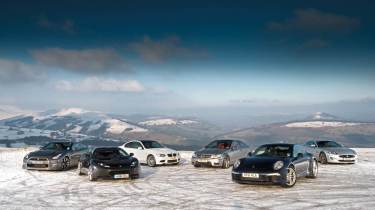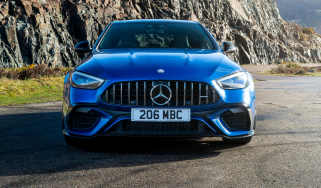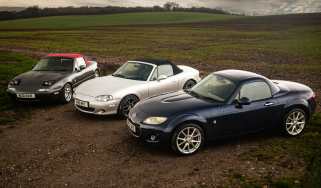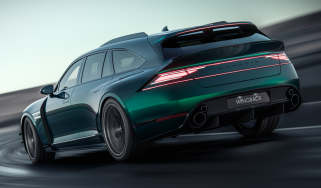Porsche 911 vs GT-R, XKR, M3, Evora and C63
The new 991-gen Porsche 911 Carrera faces its foes from Jaguar, BMW, Mercedes, Lotus and Nissan
Complacency is not an emotion with which engineers at Porsche are familiar. Indeed when ‘Mr 911’ August Achleitner and his team attended the international launch of the Gen2 997 in 2008, their minds were already immersed in creating its all-new replacement, the 991. No wonder he later confessed it was hard to express excitement about the Gen2; to him it felt like they were launching the past.
Of course, as we know only too well, the last 997 models were exceptional cars. The Carrera GTS in particular encapsulated all that’s great about 911s in one perfectly judged package, while a succession of motorsport department models took things to adrenalin-drenched extremes. For fans of Porsche’s rear-engined icon, the last four years really have been a golden age.Which is why the arrival of the 991 seems all the more momentous. Signalling a fresh beginning for the iconic sports car, with an all-new platform promising increased refinement, efficiency, dynamic stability and outright performance, the 991 Carrera and Carrera S are unquestionably amongst the most important cars that evo will drive this year.
That significance is reflected in the scale and quality of the welcoming committee we’ve assembled. In a dozen or so pages’ time, Henry Catchpole will be testing a fully loaded 3.8-litre Carrera S against a broad array of top-end opponents, but before that I’ve been tasked with driving a modestly optioned 3.4-litre Carrera against the impressive array of sub-£80K rivals you see here. It should be quite a fight.
More reviews
In-depth reviews
- Porsche 911 Carrera GTS T-Hybrid review – the first hybrid 911 is one of the best
- Used Porsche 911 (991, 2011 - 2018) review – should you buy the unloved 911?
Long term tests
Reviews
- New Porsche 911 Turbo S review – McLaren Artura performance with four seats
- RML GT Hypercar review – the Porsche 911 taken to the ultimate extreme
- Used Porsche 911 (997, 2004 - 2012) – the ultimate sweet spot 911
- Porsche 911 Turbo S (992.1, 2020 - 2024) review – Stuttgart’s supercar slayer
- Porsche 911 3.2 Carrera (1984 - 1989) review – flawed but furiously charming
It’s been a very long time since I opened the door to a Porsche 911 without a clear idea of what I was about to experience. Consequently the dark metallic blue 991 is something of a novelty. This is the first time I’ve seen one without pre-production disguise, or under dazzling motor show lights. It’s certainly no disappointment. The shape is curvier, more sumptuous, the frontal styling more expressive, the tail more memorable. The stance is broader, but it doesn’t look at all bulky. If anything it’s more lithe and athletic than the 997. It’s a very handsome car.
As soon as you sit in the driver’s seat you know you’re in a grown-up car. It looks and feels premium in a way the 997 didn’t, which is just as well given Porsche’s bullish pricing. Aside from the optional PDK transmission (£2387) and sports exhaust (£1772), this Carrera’s hardware is pretty basic. There’s no PASM adaptive suspension, PCCB brakes, Sport Chrono package or ride-enhancing, roll-reducing PDCC system. Yet still it’s just shy of £80K (up from £71,449 basic), which is big money for an entry-level 911.
The test proper starts tomorrow morning. Before then I’ve got a three-hour drive to Crickhowell in south Wales. Most of this will be on major motorways and A-roads, which is the perfect introduction to what Porsche tells us is the most refined, most comfortable and everyday-capable 911 ever. It certainly feels that way as we rasp up the slip road and onto the motorway (I thought I’d better check that the button for the sports exhaust works). Even on passive springs and dampers, the Carrera has a beautifully settled, composed feel. The extra 100mm in the wheelbase calms any propensity the previous 911 had to ‘bobble’ through undulations, while tyre noise – especially the slap-slap generated by expansion joints – is more subdued.
The 991 cruises at rather higher speeds than is strictly good for the health of your driving licence. It really does take a concerted effort to keep it below three figures, not least because the long-legged seventh gear means the engine barely nudges above 2500rpm. PDK also allows the car to ‘coast’ by decoupling the engine from the transmission (eliminating engine braking) when you’re cruising with no throttle opening – something you do more than you’d ever expect – increasing both the serenity and fuel efficiency of your journey.
A long-ish section of dual carriageway punctuated by roundabouts provides the first real opportunity to work the new 3.4-litre engine fitted to the Carrera. Freer-breathing and with fizzier cams, it’s revvier and more powerful (345bhp) than the version of the same unit that powers the ‘S’ Boxster and Cayman. It delivers 5bhp more and exactly matches the torque (288lb ft) of the 997 Carrera’s 3.6-litre engine, but these peaks arrive 900rpm and 1200rpm further round the dial respectively. Reduced fuel consumption and CO2 emissions are compensation.
There’s no disguising the Carrera’s need for revs. Below 5000rpm it pulls cleanly and with reasonable urgency, but it’s from 5000 to 7500rpm that it really thrives. It sounds fabulous, especially with the sports exhaust in full-noise mode, and there’s even a paradiddle of pops and crackles on the overrun to make you smile. The PDK ’box takes the effort out of keeping the engine on the boil, and when you’re powering between roundabouts you do get a real kick from winding it out through second, third and into fourth gear. How it feels on a more sinuous country road with give-and-take overtaking opportunities is something we’ll discover tomorrow. For now I’ll have to be satisfied with knowing the 991 is a truly sublime mile-eater.
If the proprietors of The Bear in Crickhowell notice a few extra cracks in the fabric of their lovely old hotel, I’m afraid evo is to blame. The sound of an M3, C63 AMG, Jaguar XKR, Lotus Evora S and 991 Carrera shattering the peace and quiet of a cold winter’s morning is enough to set the plates rattling on the obligatory Welsh dresser. I’ve a good mind to shout at the noisy hooligans to keep the noise down, but think better of it.
Why am I not with my bleary-eyed colleagues? Generously, I volunteered to stay in bed for another hour then eat breakfast prior to the delivery of the final piece of our group-test puzzle. Ah yes, the Nissan GT-R. Nemesis of sports cars many times its £74,450 asking price, the big Nissan has the firepower to frighten most if not all of the yet-to-be-launched 991 range, yet thanks to its freakish bhp-per-£ ratio it’s still cheaper than our Carrera test car.
The GT-R is a magnificent brute of a car. Fresh from its 2012MY refresh, it has even more power and a super-trick asymmetric chassis set-up. After the full, feminine curves of the 991, the GT-R’s chiselled features are unremittingly masculine, all jutting jaw and square shoulders. The interior lacks the 991’s quality and cohesion. The shiny metallic finish for the gear-selector surround and door handles looks cheap and is already badly scuffed in this sub-10,000-mile test car. The seats look and feel great, but the perforated leather on the steering wheel also seems a bit low-rent. You just have to remind yourself that this is a near-550bhp all-wheel-drive supercar for sub-400bhp sports car money. Ultimately, something has to give.
Refinement has never been a GT-R strongpoint, but the contrast with the Carrera is stark. I don’t happen to mind the Nissan’s chattery mechanicals, but I suspect some people would be put off immediately. The ride is back-breakingly stiff in anything but Comfort mode, so you soon learn to give the damping switch a nudge before you set off. It’s tolerable, but there’s no mistaking the GT-R’s limited (some might say grudging) concessions to everyday comfort.
The steering has proper weight to it, but there’s feel too. You can sense the front wheels walking over cambers and pulling at the crown of the road. You feel constantly connected, whether you’re doing 10mph or, ahem, rather more. The chatter from the transmission is a permanent backing track to your journey, but the immense torque and eager self-shifting mode of the gearbox makes stop-start driving pretty painless.
Away from the town, the GT-R’s extraordinary performance is laughably accessible. All you need to do is breathe on the throttle and the big-hearted twin-turbocharged 3.8-litre V6 fires you down the road with monstrous insistence; you don’t need to explore the full rev-range to gain serious speed.
In such cold temperatures (we’re surrounded by snow, although the roads remain clear) you’d expect the GT‑R’s trackday-style rubber to literally come unstuck, but it conjures grip like you wouldn’t believe. The Nissan steams on with apparent disdain for the conditions, engaging you in the process far more than its ‘computer game’ misnomer would have you believe, but not troubling you with many of Sir Isaac’s pesky laws in the process. It’s a phenomenal car.
Arriving at our rendezvous point, it’s hard to know what to try next. Then I spot the Evora S and reckon the contrast between it and the GT-R will highlight the strengths and weaknesses of both cars brilliantly.
The Lotus is a pretty car. Its delicate features and cinched waist are the polar opposite of the Nissan’s hulking frame, while its mid-engined proportions and slender body also make it seem smaller and sharper than the Porsche. It certainly feels tighter when you get in, as you really have to fold your legs to avoid scuffing them against the door.
This Evora S is equipped with the IPS paddle-shift torque-converter auto. It’s the first time I’ve tried the system and first impressions are good, both because it’s smooth and intuitive to use, but also because the manual gearbox in the Evora can be a bit snaggy between ratios.
As predicted, the contrast between the Lotus and the Nissan is almost bewildering in its severity as you struggle to contain the joy brought by the Evora’s damping and steering and the disappointment of its comparative lack of pace. There’s no question Lotus remains the master of ride and handling. There’s such subtlety to the steering and shades of grey to the damping that the Evora feels utterly controlled and reassuring, yet continually alive in your hands. There’s never any sense of it fighting the tarmac, just a hugely satisfying fluidity that enables you to find a rhythm with the road. If only all cars could feel like this.
It goes a long way to compensate for the lack of fireworks from the supercharged Toyota V6. With 345bhp and 295lb ft of torque, the Evora S is very much on a par with the Carrera for on-paper output, and a 0-62mph time of 4.8sec and a top speed of 172mph back up the parity. In certain situations the Evora’s more abundant mid-range torque scores an advantage over the Porsche, but the overall sense is of a drivetrain that’s effective but lacks the sparkle of a truly sporting engine such as the Porsche flat-six.
However, the Evora S’s biggest flaw is its price (£61,500 basic, a whopping £71,600 for this test car), for it doesn’t have the quality or refinement of the Carrera, nor does it have the same level of practicality. That’s a huge shame for a car that delivers such a high-quality driving experience, but this is a fiercely competitive sector and one in which the Lotus sadly feels out of its depth as an all-round product.
And so to the most expensive car here, the £78,550 Jaguar. It’s a rather confusing car, the XKR. The recent styling tweaks have really sharpened the looks, but inside it’s the usual mix of neat touches and slightly chintzy details. Once behind the wheel it feels compact and wieldy, which encourages you to drive it like a sports car. Where the messages begin to get mixed is in the initial feel of the major controls.
The steering is light and doesn’t feel entirely connected, and the suspension seems slightly floaty. Of course, this means the XKR rides more fluently, but it never quite delivers the same immediacy, consistency or reassurance you want from a 500bhp sports coupe. The brakes have the same cushioned feel and response, almost as though you’re driving in a pair of thick-soled shoes.
There’s no arguing with the Jaguar’s straight-line pace, though: the 5-litre supercharged engine delivers immense acceleration from very low revs through to 6000rpm, at which point it begins to soften a little. In all honesty it’s a little too much for the chassis, at least if the traction control light is anything to go by. Unless you’re particularly keen you’ll want to keep it on too, for the Jag can quickly become a bit of a handful.
Quite why Jaguar seems reluctant to provide a true tactile link between you and the car is hard to fathom. The Evora S proves you can feel connected and cosseted in equal measure, and while the Jaguar is a heavier, more powerful car, surely it has to be possible to control the mass without ruining the ride.
Of the remaining German duo, the M3 commands your gaze more readily than the strangely anonymous C63 Coupe. With the recent launches of the M5 and 1M Coupe, the M3 has been somewhat overshadowed, but there’s still plenty to love about this iconic coupe. For starters it looks great: just explicit enough to send out the right sporting signals, but not so overt as to be branded an attention seeker.
Inside, it’s typical BMW functionality, which is no bad thing. This car has the optional DCT ’box, which is mated to the M Division’s magnificent naturally aspirated 4-litre V8. With a choice of throttle response, damping and gearshift modes, the M3 is an easy car in which to find your sweet spot. As in the GT-R, I opt for the softest suspension setting, but there’s sufficient compliance in the middle mode for it to work on tricky B-roads. At 1580kg the BMW is chunkier than the Porsche and the Lotus, but usefully lighter than the rest. You can feel the extra weight in the way it has to control its mass over bumps and through corners, but it’s still satisfyingly agile. The steering isn’t the most talkative, but its rate of response is well judged: quick-witted but not so sharp as to unsettle the car on turn-in.
Like the Carrera, the M3 needs revs to sing. The seven-speed DCT helps the cause, both in terms of shift speed and ratios, but once into its stride those 414 horses (at 8300rpm!) feel more memorable than the Carrera’s 345bhp. The brakes have sweet initial response and plenty of stopping power for road use.
The BMW is also brilliantly expressive, remaining neutral and tidy when traffic or visibility dictate, yet completely comfortable at big slip angles when you have the chance. Of all the cars here, it feels like the one you’d most like to drive on track, yet it has all the comfort and refinement – more than the GT-R, but less than the 991 – that you could reasonably expect from such a potent machine. Detractors will say it’s too obviously derived from humble stock, but still I defy anyone to drive the M3 and not be deeply impressed. That it’s the cheapest car in the test (£54,690) makes it all the more compelling.
Finally I swap the M3 for the C63. It’s curious that Mercedes should build a coupe that’s neither as good-looking nor distinctive as its saloon brother, but if it’s stealth you’re after, this could be the car for you. At least until you start it up and 6.2 litres of rampant V8 burst into life.Much like the M3, this C63 feels less bespoke than the Carrera. It’s solidly built but there’s less sense of occasion when you’re sat in the driver’s seat. Still, at similar money to the BMW (£57,745) you can’t expect too much when you appreciate the class and quality of the drivetrain you have access to.
Mercedes really has a handle on what it is that makes its AMG models so appealing. There’s something magnificent about over-endowing a relatively small car with a really big engine – in this case a 451bhp, 442lb ft naturally aspirated V8 – and that’s the core of the C63’s appeal.
It’s a softer car than the M3, but it’s more generous in its delivery so you appreciate the performance more readily. Like the Jaguar, it really does struggle for traction (our test car is on winter tyres, but experience of other AMGs suggests summer tyres wouldn’t transform it), to the point where you wonder if they replace the traction control warning bulb at each service. This can be frustrating when you just want to make quick, unspectacular progress, but if you’re in the mood for fun and feel confident enough to disable the stability control, you’ll find a friendly balance and a playful nature.
The C63 is a less aggressive animal than the M3. Its teeth aren’t as sharp and it can’t raise its game in the manner of the M Power BMW. It doesn’t have the grip or the traction to fully exploit the potency of its engine, nor can the torque-converter automatic deliver the immediate up- and downshifts that enable you to drive the M3 so hard. That’s not to say the C63 is completely outgunned, just that it plays by a slightly different set of rules.
It feels good to slide back behind the 991’s steering wheel. It feels lower slung than all but the Evora, which immediately makes it feel like a dedicated sports car. The hints of added composure and stability I felt on the way up here last night come to the fore on this ducking, diving hill road, the Carrera remaining unflustered at big speeds over bumps and into compressions that I know would have tied a 997 in a bit of a knot. It also has an abundance of grip, virtually no ‘bob’ from the front end and tons of traction.
What’s not immediately forthcoming is the sense of intimacy through the steering you got from a 997. I’m painfully aware that journalists have said the same thing for more than four decades, yet the truth is that in ironing out the previous 911’s wrinkles – and in fitting electric power steering – Porsche has erased some of its harmless but engaging characteristics.
It’s still a special car to drive fast, but only when you really push it hard. It maximises its performance to terrific effect – in fact I doubt 345bhp has ever been put to better use – but if the wider track and longer wheelbase result in there being fewer secrets to unlock, it also explains why the 991 has less to say. If you appreciated the 911 for its unconventional approach and the technique you needed to learn to get the best from it, then that’s a big shame, for it was the rich dialogue between road, car and driver that always provided the great differentiator between 911s and other cars.
So which car takes the spoils? Despite all having great strengths, the weaknesses of the Jaguar, Lotus and Mercedes deny them shots at the top three places. Hampered only by its lack of tactility, the new Porsche’s all-round polish secures second place by some margin from the enduringly able and appealing BMW.
That means Nissan’s GT-R gets the win, and by some margin. True, it’s not to all tastes, but then you could say the same about any of these cars. What sets it apart is its jaw-dropping performance. Very few cars possess such swagger and exuberance, fewer still combine it with everyday practicality, supercar kudos and a £74K price tag. Its legend is well deserved.
Meaden gets to grips with the new 911 Carrera below...



